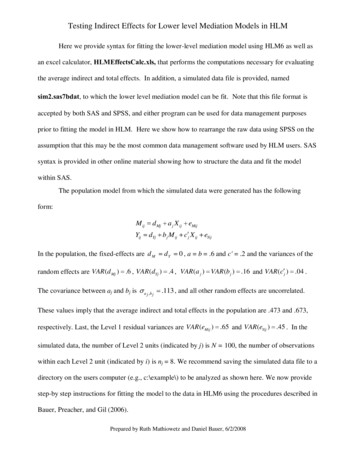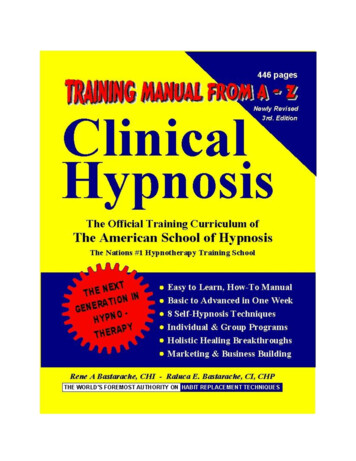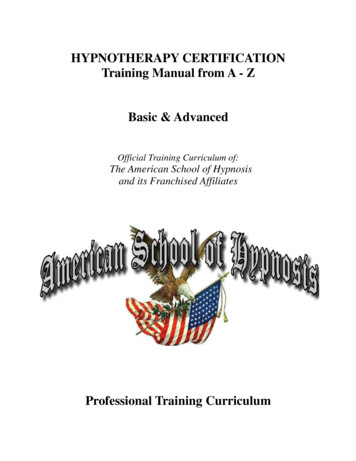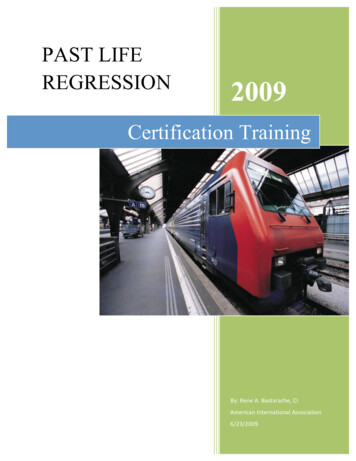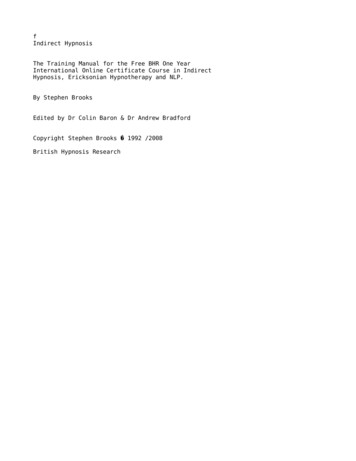
Transcription
fIndirect HypnosisThe Training Manual for the Free BHR One YearInternational Online Certificate Course in IndirectHypnosis, Ericksonian Hypnotherapy and NLP.By Stephen BrooksEdited by Dr Colin Baron & Dr Andrew BradfordCopyright Stephen Brooks 1992 /2008British Hypnosis Research
Copyright and DistributionFree DistributionThis eBook is for free worldwide distribution. Please feel free todistribute it to your friends and colleagues in any way that empowerspeople to transform lives. You are not allowed to print, sell, edit, or claimauthorship of this eBook in any way. Other free eBooks and audio filesare available from www.british-hypnosis-research.comStephen Brooks has a lifetime s experience of using indirect hypnosiswith severe problems and difficult patients. Inspired and encouraged bytop American Psychiatrist Milton H Erickson, he was the first person tointroduce Ericksonian Hypnosis into the UK in the mid 1970's. Sincethen, his own innovative indirect therapy techniques have had a majorinfluence on the health professions both in the UK and Europe and havechanged forever the perception of hypnosis and how it should be usedwithin therapy.He is founder of British Hypnosis Research (1979) and the BritishSociety of Clinical and Medical Ericksonian Hypnosis (1995), both majortraining bodies for the caring professions. His two-year Diploma coursesbecame the standard training for thousands of health professionals andover a period of 15 years he taught indirect hypnosis courses in over 27major British hospitals. His Diploma courses also became the standardtraining for hypnotherapy associations and organisations in France,Belgium, Spain, Ireland, Malaysia and Singapore. In 1991 he wasawarded special acclaim when archive recordings of his work werepreserved in the British National Sound Archives.He specialised in innovative approaches to Indirect Hypnosis with anemphasis on demonstrations with real patients during his training courses,something that many trainers are still afraid to do. A common thread inBrooks work is his humour, compassion and creative approach totherapy and his deep respect for the unique needs of the patient. Hetreated problems by spontaneously doing what is most unexpected butalways most appropriate for the patient at the time, quickly tailoring eachtherapy session to the patient.He is now responsible for the design and teaching of the British HypnosisResearch online academic hypnosis course which is available to serious
students of hypnosis free of charge. He also teaches internationally inseveral countries.students of hypnosis free of charge. He also teaches internationally inseveral countries.British Hypnosis Research.
The Art of Indirect HypnosisThe Art of Indirect HypnosisAcknowledgementsForewordIntroductionPart One - Opening the DoorOpen communicationDefine the problemDevelop trustRoot causeSecondary gainObserve non-conscious responsesPart Two - Digging DeeperSubjective interpretationsNegate negative interpretationsBe one step aheadLook and listen but mostly lookVerbal and non-verbal metaphorsCongruency and insightOrganic MetaphorsChapter 3 - The Nature of the Beast Trying is not succeedingThe relationship between cause and symptomNon-conscious commentariesWords are not meaningChallenge negative nominalisationsTherapeutic nominalisationsChapter 4 - Building EmpathyRapport buildingBreathing in harmonyReflective speechThe agreement setPositively Framed SuggestionsReverse Frame SuggestionTag Questions
Response attentivenessMatching predicatesSensory re-presentationSensational representationResponse attentivenessMatching predicatesSensory re-presentationSensational representationWell formed outcomes1. What positive change do you want?2. How will you know when it has happened?3. What has stopped you from changing so far?4. What do you get out of what you're doing now?5. Do you want this change in all contexts?6. What could go wrong?Polarity responsesResponding to Polarity ResponsesAccessing resourcesChapter 6 - Visible TranceDeeper trance statesMinimal Cues1. Eye fixation2. Pupil dilation3. Change in blink reflex4. Rapid Eye Movement5. Eyelid Flutter6. Smoothing of facial muscles7. Slowing of respiration8. Reduction of the swallow reflex9. Body Immobility10. Inner absorptionEveryday tranceUtilisationTailored therapyChapter 7 - Therapeutic StrategiesTherapeutic structuresTherapeutic metaphorsSymptom substitution and resolutionSensory dissociation techniquesScrambling symptomsThe Swish Technique
Chapter 8 - Artful SuggestionChapter 8 - Artful SuggestionChapter 9 - Trance PhenomenonNon-conscious signallingAnchoringAbreaction and TraumaChapter 10 - Multiple MirrorsMultiple dissociationCrystal gazingDistorting timeChapter 11 - Snowballing EffectsFuture planningFuture PacingPseudo-orientation of timeSteps for Pseudo-orientation in timeLingering suggestionsTrance recallChapter 12 - More Indepth ApproachesTeaching your Patient Self HypnosisHypnotic AmnesiaHypnotic AnesthesiaPain ControlSelf suggestions and dissociationPart Two: The Sussex University Therapy Session TranscriptTo purchase the double DVD training set based on this therapy session,with a running commentary plus interviews, please go to the BHR onlineshop: British Hypnosis Research.
AcknowledgementsAcknowledgementsIn particular, I would like to thank the following people who have shapedthe way I work. Dr Milton H Erickson and Dr Ernest Rossi in the 1970 s,Virginia Satir for showing me how to love my patients, AjahnBuddhadasa for teaching me non-attachment, the Shamans of Chiang Daofor teaching me to navigate the spirit world, His Holiness the Dalai Lamafor teaching me humility, gratitude and how to walk on water, mypatients for their trust, my trainers and staff at British Hypnosis Researchand the international hypnosis organisations who have promoted mycourses with such enthusiasm, Dr Andrew Bradford and Dr Colin Barronfor giving up their valuable time to edit this book. Lastly, I would like tothank those closest to me for their unconditional love in giving me thespace to live my minimal lifestyle. True wealth consists in being contentwith little.Stephen H Brooks
Foreword by Igor LedochowskiForeword by Igor LedochowskiStephen originally learned his craft at one of the old schools. He wasbright enough to realise the limitations of the old system and, dissatisfied,he sought better alternatives. After much searching, he eventually foundthe legendary Erickson and began to learn new ways of using hypnosis totransform people. Stephen became very good with people. His practicefilled to cover six different towns.In time he mastered his craft. Like every other true master, he then startedto develop the field of indirect hypnosis in exciting new directions. Manypeople, including health care practitioners from around the globe, came tolearn from Stephen. His Diploma Course in Indirect Hypnosis became thegold standard in six countries.His series of ebooks, audio lectures and workshops covers Stephen'spatterns and discoveries in indirect hypnosis and minimal therapy. Theycover over thirty years of experience in clinical hypnosis. Hispublications belong in every therapist s practice for two reasons:Firstly, his archive of training materials is one of the most comprehensivesources of material to cover all of the technical aspects of indirecthypnosis as applied to therapy. It covers more than the technical aspectsof inducing trance, it shows you how the pieces fit together in atherapeutic context.Secondly, you will find within his material a way of being with yourpatients that is both respectful and powerfully effective. Stephen hasdrawn on his experiences of Buddhism and a deep respect for nature toshed light on our human nature. His approach is pragmatic, humanisticand in many ways deeply spiritual. His philosophy is at oncesophisticated and simple, like his lifestyle: people are a part of nature and,like all natural systems they will find balance and harmony as soon asthey get out of their own way for long enough to allow their nature toexpress itself unhindered.While the structure of therapy is illustrated by the technical information,
Stephen also gives numerous case histories that bring the spirit - orperhaps more accurately the spirituality - of his life's work to life. Youwill no doubt find these case histories at once charming, illuminating,inspiring and thoroughly absorbing. As good as these are, they do not dofull justice to Stephen Brooks and the way he finds a roadmap deep intohis patient's non-conscious minds. To experience that you should reallysee Stephen in action.Stephen also gives numerous case histories that bring the spirit - orperhaps more accurately the spirituality - of his life's work to life. Youwill no doubt find these case histories at once charming, illuminating,inspiring and thoroughly absorbing. As good as these are, they do not dofull justice to Stephen Brooks and the way he finds a roadmap deep intohis patient's non-conscious minds. To experience that you should reallysee Stephen in action.
IntroductionIntroductionAs the name implies, indirect hypnosis is the opposite from the directauthoritarian approach to hypnosis used by most therapists during the 20thcentury. The indirect form of hypnosis and psychotherapy taught in thisbook allows the therapist to by-pass the patient s normal consciousresistance to suggestions. Because this approach is so indirect, therapistscan now use hypnosis effectively in areas of the caring professionspreviously unfamiliar with hypnosis. Through the work of StephenBrooks in the UK, indirect hypnosis is now widely applied in the socialservices, nursing, counselling and psychology in addition to the moretraditional contexts of medicine and dentistry.When Brooks wrote this book he was teaching at various hospitals in theUK and this book became the standard training manual for those courses.He was working in a minimalist style using indirect hypnosis with someadditional NLP. This book contains the results of that integration. Brookshad not fully developed his principles of Minimal Therapy at this time,although his work was always brief and simple. The first part of this bookintroduces the various principles and techniques of indirect hypnosis. Theemphasis is on the application of indirect hypnosis in therapeutic settings,however the concepts and skills taught will be of interest to all seriousstudents of communication and influence. So persuasive are the indirecthypnotic techniques taught, that the author stresses the importance ofapplying the skills only for the benefit of others and suggests that allserious students acquire professional training before using the skills withpatients. This emphasis on integrity runs through all of Brooks' work andfor the serious student of indirect hypnosis, this book should ideally beused as an adjunct to actual attendance on a training course.A transcript of an indirect hypnosis therapy session with a commentaryby Brooks is featured at the end of this book. The demonstration is alsoavailable separately on DVD and readers are recommended to acquirethis if possible to refer to while reading the transcript and author scommentary.
Chapter One - Opening the doorChapter One - Opening the doorWhen two people meet for the first time they know nothing about oneanother. It is the therapist's job to be observant and ask questions to startthings rolling. It is important to ask open-ended questions that elicitrelevant information. Open-ended questions cannot be answered with a yes or no and usually start with who, what, where, how, when etc .Questions such as "What made you decide to see me?" will elicit arelevant, content rich response. This can be used to help understand thepatient's problem and build rapport. Good rapport between the patient andthe therapist enables more open discussion and is itself therapeutic for thepatient. Therapeutic intervention does not require detailed knowledge ofthe patient s problem and sometimes the patient may be reluctant todiscuss their problem openly so early in the therapeutic relationship.Define the problemEvery symptom or problem behaviour has a beginning, a middle and anend. Attempt to identify any triggers and the subsequent sequence ofevents experienced by the patient. By recognising the sequence of eventsexperienced as feelings, pictures, sounds or actual experiences thetherapist gains valuable insight. Identify the date or the time in theperson's life when the problem first started. This includes significanttimes in the person's life when the problem has been at its worst. It mightalso be useful to identify any times prior to the problem starting when thepatient felt similar feelings. Identify the frequency of the symptom orbehaviour. You might also like to identify where it occurs and withwhom. You need to know how long the symptom or behaviour lasts.You should also identify any other events, happenings, experiences ortraumas that have occurred at about the same time that the problem firststarted or developed. Maybe one of these events has indirectly triggeredor started the problem. Therapy should also attempt to identify howfamily and friends view the patient's behaviour or symptoms. Thesymptom may only occur in the presence of certain family members. Byidentifying the relationships between the patient and the people aroundthe patient the therapist will gain a deeper understanding.It is equally important to identify the times in the person's life when they
have not had the symptom. This is especially important when the personhad expected to have the symptom or problem and it did not occur. Thepatient's subjective understanding of the problem will often be vague andthey will often be unable to say specifically why the problem exists, soyou need refined and unobtrusive questioning skills.have not had the symptom. This is especially important when the personhad expected to have the symptom or
The Training Manual for the Free BHR One Year International Online Certificate Course in Indirect Hypnosis, Ericksonian Hypnotherapy and NLP. By Stephen Brooks Edited by Dr Colin Baron & Dr Andrew Bradford Copyright Stephen Brooks 1992 /2008 British Hypnosis Research




